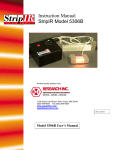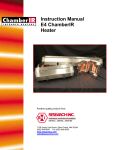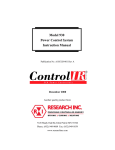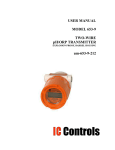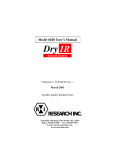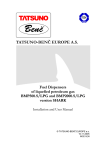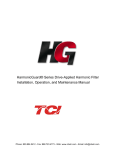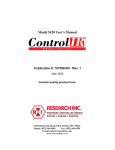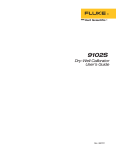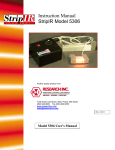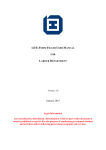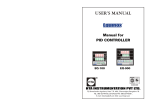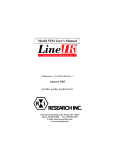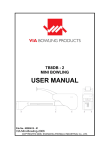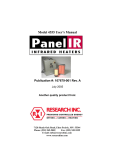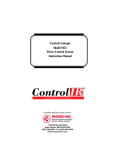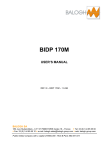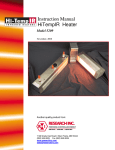Download ControlIR Model 915 User Manual - Precision Control Systems, Inc.
Transcript
Instruction Manual ControlIR 915 Another quality product from: 7128 Shady Oak Road • Eden Prairie, MN 55344 (952) 949-9009 Fax (952) 949-9559 www.researchinc.com [email protected] Rev.052909 Contents Contents Introduction ..................................................................................................................................... 1 General Description .................................................................................................................... 1 Standard Features ........................................................................................................................ 1 Optional Features ........................................................................................................................ 2 Safety .............................................................................................................................................. 3 Installation....................................................................................................................................... 4 Mounting the System .................................................................................................................. 4 Wiring Connections .................................................................................................................... 5 Power Wiring Connections ..................................................................................................... 6 Control Connections ................................................................................................................... 6 Cooling Flow On/Off Relay Output ....................................................................................... 6 Cooling Flow Switch Interlock ............................................................................................... 6 Heater Over-Temperature Thermo-switch Interlock .............................................................. 6 Remote Interlock Switch......................................................................................................... 7 Heater Open Switch Interlock ................................................................................................. 7 Remote Setpoint Input ............................................................................................................ 7 Temperature Control Option Connections (Option Codes TCT & TCP) ............................... 7 Operating Instructions..................................................................................................................... 9 Controls and Indicators ............................................................................................................... 9 Main Disconnect Switch ......................................................................................................... 9 Heater ON/OFF Switch........................................................................................................... 9 Cooling ON/OFF Switch ........................................................................................................ 9 Heater On Indicator................................................................................................................. 9 Cooling On Indicator .............................................................................................................. 9 Heater Over Temperature Indicator ........................................................................................ 9 Lamp-Out Indicator .............................................................................................................. 10 Remote/Local Setpoint Switch ............................................................................................. 10 Local Setpoint Potentiometer ................................................................................................ 10 Load Volts Indicator (Option Code VM).............................................................................. 10 Temperature Control Option ..................................................................................................... 11 Setup Summary ..................................................................................................................... 11 Theory of Operation .................................................................................................................. 11 Principles of SCR Power Control ......................................................................................... 11 Principles of Phase Angle Control ........................................................................................ 12 Maintenance & Troubleshooting .................................................................................................. 16 Routine Maintenance ................................................................................................................ 16 Troubleshooting ........................................................................................................................ 16 Calibration................................................................................................................................. 17 Power Controller ................................................................................................................... 17 Panel Voltmeter Calibration ................................................................................................. 17 Temperature Controller Option............................................................................................. 18 Line Voltage Re-Configuration ................................................................................................ 18 Section 1 Introduction General Description The Model 915 power control system is a complete power control “solution” featuring a number of elements integrated into a single, ready-to-install package. The Model 915 is a single-phase power control system available in a variety of configurations from 120 to 480 volts and rated at 20-, 40-, or 70-amps. These systems are ideally suited for many industrial power control applications and have been specifically optimized for use with Research Inc. infrared heating systems. Standard Features Standard features include: • Local 10 turn potentiometer with digital dial for precise manual control of load voltage. • Remote control capability with a 0-5 VDC or 0-20 mA signal. • Heater power switch with remote interlocks. The load voltage may be enabled or disabled without turning off the main discount switch. • Heater ON/OFF switch controls an AC contactor to remove power from the SCR controller and the load. • Cooling power switch to control air or water cooling flow. • Cooling flow interlock contacts. Low cooling flow turns off the heater contactor. • Heater over temperature contacts. Heater over temperature condition turns off the heater contactor. • Indicators lights for heater on, cooling on, heater over temperature, optional temperature controller alarm and lamp-out alarm. • Fail safe operation of the heater contactor. The contactor will not automatically reenergize after a power failure, or an alarm condition that shuts down the heater. • Programmable Logic Controller for operating and alarm logic control. Page 1 of 21 Optional Features The following options are available: Automatic Temperature Control Option The automatic temperature control option allows the power level to be adjusted based on an entered temperature setting for the process. The temperature controller uses PID type control and is pre-wired for a “K” type thermocouple (option code TCT) or a 4/20mA pyrometer signal (option code TCP). Voltmeter Option The true RMS load voltage is displayed with a digital meter. A true RMS voltage transmitter is provided for isolation and operator safety. Lamp-out Detection Option The lamp out detection option is designed to detect a lamp failure or load loss when using multiple infrared heaters or zones of lamps in a single heater. The lamp out indicator flashes during this condition. Page 2 of 21 Section 2 Safety !WARNING! Hazardous voltages are present at the main disconnect switch and load terminals. Setting the setpoint potentiometer or control signal to minimum does NOT eliminate these hazardous voltages. Always remove AC line voltage from the system before making contact with internal assemblies, line or load wiring, or fuses. Also remove AC line voltage from the system before making connections, equipment changes, or resistance measurements. !CAUTION! Up to 480 volts AC is present within the power control solution system. Do not make any wiring connections when power is applied. Disconnect power before performing any maintenance or service to the system. Use extreme caution when adjusting calibration potentiometers on modules when power is applied. Always use an isolated oscilloscope for checking waveforms. Page 3 of 21 Section 3 Installation This section describes how to install and wire the Model 915 power control system. The features and options mentioned here are identified in the model number found inside the enclosure. !WARNING! Hazardous voltages are present at the main disconnect switch and load terminals. Setting the setpoint potentiometer or control signal to minimum does NOT eliminate these hazardous voltages. Always remove AC lien voltage from the system before making contact with the internal assemblies, line or load wiring, or fuses. Also remove AC line voltage from the system before making connections, equipment changes, or resistance measurements. Mounting the System The Model 915 Power Control System may be mounted to a wall with the supplied brackets, on a stand, or bench. The Model 915 must be mounted in a vertical position. When mounting to a wall, the top of the enclosure should not be over 74 inches (1880 mm) above the floor. Figure 3-1 shows the mounting dimensions using the supplied brackets. Attach the brackets to the enclosure with the hardware provided. Allow a minimum of 4 inches (100mm) clearance on the right and left sides of the system. Allow a minimum of 30 inches (762 mm) in front of the system. Page 4 of 21 Wiring Connections The weight of the Model 915 varies slightly with the options installed. The maximum weight of the system is 110 pounds (50 kg). Conduit entry into the system should be made near the right side of the cabinet for power wiring, near the center of the cabinet for load wiring, and near the left side for 120 VAC control wiring. Assure no metal fragments are allowed to fall into the equipment while holes are made for conduit fittings. We suggest a separate conduit entry should be made for low level DC control wiring if used. This includes the remote setpoint input or thermocouple wire (temperature control option). Wire Ratings: Wire Temperature Rating: Line/Load Wiring Voltage Rating (120/240 VAC) Line/Load Wiring Voltage Rating (480 VAC systems) Control Wiring 75° C or Higher 300 VAC Minimum 600 VAC Minimum 300 VAC Minimum Allowable Wire Sizes: Current Rating of System 20 Amp 40 Amp 70 Amp Line Connection Load Connections Ground Connections 14-8 AWG 12-4 AWG 10-1 AWG 14-2 AWG 14-2 AWG 14-2 AWG 14-4 AWG 14-4 AWG 14-4 AWG Control Circuit Connections 22-10 AWG 22-10 AWG 22-10 AWG NOTE: Wire temperature and connector ampacity ratings are based on NEC 310-16 using 75°C copper wire derated for 50°C ambient environment. Recommended Minimum Wire Sizes: Current Rating of System 20 Amp 40 Amp 70 Amp Line Connection Load Connections Ground Connection 12 AWG 8 AWG 4 AWG 12 AWG 8 AWG 4 AWG 12 AWG 10 AWG 8 AWG Control Circuit Connections 16 AWG 16 AWG 16 AWG Electrical Inputs: Heater open interlock switch Contacts Rated for 120 VAC at 2.0 A Cooling flow interlock switch Contacts Rated for 120 VAC at 100mA Heater Over-temp. thermo switch Contacts Rated for 120 VAC at 100mA Remote interlock switch Contacts Rated for 120 VAC at 100mA Table 3-1 Page 5 of 21 Power Wiring Connections Line Connections Referring to the wiring specification in table 3-1, connect the external power lines to the top of the disconnect switch. Load Connections Connect the load to power block PWB 200 load 1 and 2 terminal. Control Connections Refer to Figure 3-2 for connection of the followings items. NOTE: All systems are shipped with a complete set of electrical schematics that depict the “as built” version of the cabinet. Refer to these schematics along with this manual when making connections. Cooling Flow On/Off Relay Output This feature provides a normally closed and open (form C) dry contact relay output to control cooling flow. Connect the cooling solenoid/chiller/contactor circuit to TB-100 pins 24 (NC), 25 (COM), 26 (NO) as required. Cooling Flow Switch Interlock This feature provides shutdown of the heater power in case of low or no cooling flow. This is accomplished by opening the heater power controller contactor. The cooling sensor may be a water flow or air flow switch. Use a switch with contact that are open during the fault condition. Connect the flow switch to TB 100 pins 2 and 3. If both water and air cooling flow switches are used in a system, wire the switches in series and then connect to the system. Heater Over-Temperature Thermo-switch Interlock This feature provides shutdown of the heater power in case of a heater over-temperature. This is accomplished by opening the heater power controller contactor. If a thermo-switch is not included with your heater, use a thermo-switch with contacts that will open during the overtemperature condition. If this feature is desired or provided with the heater, connect using the following procedure: • Remove the factory installed jumper at TB 100 pins 4 and 5. • Connect the thermo-switch to TB 100 pins 4 and 5. • If more than 1 thermostat is used, in a system, wire the switches in series and then connect to the system. Page 6 of 21 Remote Interlock Switch This feature provides for remote process interlock shutdown of the heater power. This is accomplished by opening the heater power controller contactor. With the interlock open, the heater can not be turned on from the control system front panel. The switch contacts must be open during the heater off condition. If this feature is desired, connect using the following procedure: • Remove the factory installed jumper at TB 100 pins 10 and 11. • Connect the normally open contacts of the switch to TB 100 pins 10 and 11. • If more than 1 interlock switch is used in a system, wire the contacts in series and then connect to the system. Heater Open Switch Interlock This feature provides shutdown of the heater power if the heater is opend during operation. This switch directly interlocks power to the heater contactor. If a heater cavity open switch is not included with your heater, use a switch with contacts that are open when the heater is open. To implement feature, connect using the following procedure: • Remove the factory installed jumper at TB 100 pins 14 and 15. • Connect the normally open contacts of the switch to TB 100 pins 14 and 15. • If more than 1 heater open interlock switch is used in a system, wire the contacts in series and then connect to the system. Note: If a remote Emergency Stop switch is desired, wire the switch (push/pull type with maintained contacts) in series with the heater open switch. Remote Setpoint Input This feature allows the power level of the system to be controlled from a remote location or device. This is accomplished by applying a 0-5 VDC or 0-20 mA signal input from a remote source. This feature is not available when the “Temperature Controller” option is installed. If this feature is desired use the following procedure. • For a 0-5 VDC input, connect the source to TB 100 pins 16+ and 17-. • For a 0-20 mA input, connect the source to TB 100 pins 16+ and 17-. Also install a 250 ohm resistor across terminals TB100 16+ and 17-. Temperature Control Option Connections (Option Codes TCT & TCP) Temperature control option “TCT” is setup to use a ‘K’ type thermocouple for the temperature input. Temperature control option “TCP” is setup to use a pyrometer for the temperature input. Alarm connections are provided if required for your process. The alarm contacts are ‘dry’ type rated for a maximum of 3 Amps resistive at 240 VAC. If desired the process temperature alarm may be connected to the Front Panel Over-Temp Alarm Indicator. Make connections as follows: • “TCT” option: Use ‘K’ type extension wire from the thermocouple to the system connections. Connect the ‘K’ thermocouple extension wire to TB 100 pins 18+ and 19-. • “TCP” option: The pyrometer should source the 4-20 mA current through its circuitry. If a ‘2 wire’ pyrometer is used, an external power supply must be used. The model 935 does Page 7 of 21 • not source current for pyrometer operation. Connect the 4-20mA signal to TB 100 pins 18+ and 19-. “TCT” and “TCP” options: To use the alarm output as an external process alarm. Connect the device for the alarm output to TB 100 pins 20 and 21. If a remote alarm output is not used, the alarm may be connected to the front panel over-temp alarm indicator. Connect TB 100 pin 20 to pin 8 and TB 100 pin 21 to pin 11. The alarm indicator will flash while the temperature controller is in an alarm condition. Figure 3-2 Page 8 of 21 Section 4 Operating Instructions Controls and Indicators Figure 4-1 shows the location of the controls and indicators. Main Disconnect Switch The main disconnect switch turns on and off the power control system. Note the following: Before turning on the disconnect switch, check the following: • The load is wired and ready for power to be applied to it. • All safety precautions are observed. Heater ON/OFF Switch The heater ON/OFF switch allows the operator to enable or disable the power going to the load. This is accomplished by removing power from the AC contactor. This in turn removes power from the SCR controller. The cooling on indicator must be on before the heater power can be turned on. Cooling ON/OFF Switch The cooling ON/OFF switch allows the operator to turn on or off the heater cooling. Heater On Indicator • Indicator light on steady indicates power is applied to the heater power controller. • Indicator light flashing indicates that the Remote Interlock is open and heater power can not be applied. Cooling On Indicator • Indicator light on steady indicates adequate cooling flow. • Indicator light flashing indicates that the cooling is in a one minute shutoff delay cycle. The one minute delay cycle is activated any time that the heater power contactor is opened, after the initial heater on cycle is activated. Heater Over Temperature Indicator • Indicator light on steady indicates a heater over temperature condition. A heater over temperature condition will open the heater power contactor, removing power from the heater. • Indicator light flashing indicates a process over temperature alarm. This feature is available only if the Temperature Control Option is installed. The indicator will flash only as long as the process alarm exists. Page 9 of 21 Lamp-Out Indicator • Indicator light flashing indicates a lamp out condition. This feature is available only if the lamp out (LL) option is installed. The alarm will remain on as long as the lamp out condition exists. Remote/Local Setpoint Switch The remote/local setpoint switch allows the operator to select the source for the power level setting to the load lamps, or heaters. The selections include: 1. LOCAL: The power level is adjusted using the digial 10-Turn “LOCAL SETPOINT” potentiometer. 2. REMOTE: The power level is controlled from a remote location or device or the power level is controlled by the temperature controller when the TCT/TCP temperature controller option is installed. The operator will enter a desired temperature setpoint for the process. The power level is adjusted based on the feedback from the temperature sensor connected to the process. This selection is applicable to systems with the “Temperature Controller” option. Local Setpoint Potentiometer The power level is adjusted using the digital 10-Turn “LOCAL SETPOINT” potentiometer when the “Setpoint” switch is in the ‘Local’ position. Load Volts Indicator (Option Code VM) This option provides indication of the “True RMS” load voltage. Page 10 of 21 Temperature Control Option This section contains temperature controller configuration information for your system. Refer to the model XT19 installation and instruction manual for operating the temperature controller. Setup Summary Table 4-1 displays factory configurations made for your system: Sensor input (TCT option) Sensor input (TCP option) Control Type: AL 1 (alarm 1): Control output: ‘K’ type thermocouple scaled 0-2500 deg. F 4-20mA signal scaled 0-2500 deg. F PID (proportional, integral, & derivative) Full scale high, non-latching, set for 2000 deg. F (This alarm will trip a relay connected to TB100 pins 13 and 14.) 0-20 milliamps The alarm may be re-configured as necessary for your process Theory of Operation Principles of SCR Power Control SCR type power controllers control power by regulating when silicon controlled rectifiers (SCRs) conduct AC line current to the load. A SCR is a solid-state, electronic switching device that turns on (fires) very quickly when a lowlevel “gating” signal is applied to its gate electrode. The timing of the gating signal, and therefore the length of time the SCR conducts, is determined by the controller’s firing circuitry in response to a control signal. The greater the percentage of time the SCR is on, the greater the average power it allows to pass through to the load. The Model 915 uses a random-fire solid state relay within its SCR poser controller. This relay is a package consisting fo 2 SCRs and a gate drive circuit. During the positive half-cycle of the AC line voltage the SCR’s anode is positive with respect to its cathode, so during that half-cycle the SCR will begin to conduct whenever a gating signal is applied to its gate electrode (see figure 4-2). Once turned on, an SCR will continue to conduct until its anode-to-cathode voltage drops to zero, so the SCR continues to conduct until the end of the half-cycle. Page 11 of 21 CATHODE ANODE GATE INPUT LINE VOLTAGE OUTPUT LINE VOLTAGE GATING SIGNAL FIRING CIRCUITRY CONTROL SIGNAL Figure 4-2 Conduction of one SCR when turned on at the beginning of a half-cycle. Because an SCR is a type of diode, it can conduct only during every other half-cycle of the applied voltage. Therefore, SCR’s used to control AC power are usually installed in pairs, connected in reverse-parallel, as shown in figure 4-3. One of the SCRs then can be fired during the positive half-cycle and the other can be fired during the negative half-cycle. SCR 1 SCR 1 SCR 2 INPUT LINE VOLTAGE SCR 2 GATING SIGNAL OUTPUT LINE VOLTAGE GATING SIGNAL FIRING CIRCUITRY CONTROL SIGNAL Figure 4-3 Conduction of two SCRs connected in reverse parallel when turned on at the beginning of half-cycles. Principles of Phase Angle Control In phase angle controllers, the SCRs conduct during all or part of every half-cycle. When delivering full power, the SCRs start conducting at the beginning of the AC half-cycles. When delivering less than maximum power, the gating signal is de-layed so the SCRs start conducting some time later than the beginnings of the half-cycles. Operation of a phase angle controller at partial output is depicted in figure 4-4. Page 12 of 21 SCR 1 SCR 1 SCR 2 INPUT LINE VOLTAGE SCR 2 OUTPUT LINE VOLTAGE GATING SIGNAL GATING SIGNAL FIRING CIRCUITRY CONTROL SIGNAL Figure 4-4 Conduction of two SCRs connected in reverse parallel when turned on after the beginning of the half-cycles. The average power a phase angle controller delivers to its load is determined by the number of electrical degrees by which the gating signal that turns on the SCRs is delayed past the beginning of the half-cycles. The later in each half-cycle the SCRs fire, the less the time the SCRs conduct during each half-cycle and, there, the less power is delivered to the load (see figure 4-5). The o-5 VDC control signal received by the phase angle firing-circuit determines the amount by which the gating signal is delayed. Page 13 of 21 135° PHASE ANGLE LOW POWER OUTPUT 0° 90° 180° 270° 360° 90° 180° 270° 360° 90° PHASE ANGLE MEDIUM POWER OUTPUT 0° 90° 180° 270° 360° 90° 180° 270° 360° 90° 180° 270° 360° 45° PHASE ANGLE HIGH POWER OUTPUT 0° 90° 180° 270° 360° AC PHASE ANGLE AC LINE VOLTAGE OUTPUT VOLTAGE TO LOAD Figure 4-5 Phase angle power control The output voltage of a phase angle controller does not change linearly with respect to the number of degrees the SCR conduction phase angle changes. Therefore, the SCR controllers have a built-in load feedback circuit to linearize the relationship between the control signal and the voltage output. The feedback circuit also adjusts the power controller output to compensate for changes in line voltage and load impedance (this is called “line and load regulation”). Phase angle power control offers a number of attractive features. Because the power controller output level is adjusted by varying the SCR on time within each AC half-cycle, the controller’s Page 14 of 21 output is quite constant, rather than being divided into multiple-cycle periods of on time and off time. In addition, a variety of feedback and output indication (metering) circuits can easily be incorporated into the controller. Page 15 of 21 Section 5 Maintenance & Troubleshooting Routine Maintenance The following bimonthly routine maintenance is suggested. 1. Remove power connection to the system. Lock out power if possible. Carefully vacuum any dust or dirt collecting within the enclosure. Use caution to not disturb the wiring. Service more often in dusty locations. 2. Clean the outside of the enclosure with glass cleaner and a soft cotton cloth as necessary. Troubleshooting Symptom Heater Contactor will not energize No output to load, heaters, or lamps. Setpoint switch is in LOCAL mode. No output to load, heaters, or lamps. Setpoint switch is in REMOTE or AUTO. Operation O.K. with setpoint switch in LOCAL. Full voltage cannot be obtained. Load voltage will not go to zero. Action 1. Verify line voltage is applied to the main disconnect switch. 2. Verify remote heater open, remote process interlocks or water flow switches (if used) are closed. 3. If not using remote heater enable interlocks or water flow switches, verify the 2 pin jumpers are installed between TB 100 pins 2 to 3, 10 to 11, and 14 to 15. 4. Check fuses FU 1050, FU 1051, FU 107, FU 108 and TB 100 pin 1. 1. Verify a 0-10 VDC signal is present on pins 2 and 3 of the 4-pin power controller connector. This voltage is proportional to the setting of the local setpoint potentiometer. 2. Verify that 24 VAC is present on the 2-pin connector of the power controller. 3. If the COMMAND led on the power controller is not lit and the local setpoint potentiometer is set greater than 100, refer to the power controller manual regarding repairs. 1. Verify the polarity of the remote input. TB 100 pin 16 is positive, and 17 is negative. 2. Units with Temperature control option: Place temperature controller in manual mode with 50 percent output. Verify 2.5VDC at TB 100 pins 16 and 17. Refer to the temperature controller manual regarding repairs. 1. Verify the line voltage. Load voltage maximum is approximately 98 percent of the line voltage. 2. Test in LOCAL setpoint mode. Set the ‘Local Setpoint’ potentiometer to 900. The voltage should be 108 (120 volt line), 216 (240 volt line), or 432 (480 volt line). Adjust the SPAN potentiometer of the power controller as necessary. 3. Refer to the power controller manual regarding repairs. 1. Test in LOCAL setpoint mode. Set the ‘Local Setpoint’ potentiometer to 000 dial divisions. Adjust the zero potentiometer until the voltage is 0 volts. Page 16 of 21 Calibration Generally components of the power control system hold their calibration very well over a long period of time. Usually verification of calibration is all that is necessary. We suggest verification or calibration be performed on a yearly basis. Calibration should be performed by qualified personnel as dangerous voltages are present. Power Controller Refer to the power controller manual for specific calibration instructions. Calibrate using step 1, 2 or 3 below (use whichever is used most often): 1. When LOCAL setpoint mode is selected, the local setpoint potentiometer is used as the source for the input. Adjust the zero and span potentiometers on the power controller. The SPAN potentiometer is adjusted for 90 percent or rated line voltage for 900 dial divisions of the local setpoint pot. The ZERO potentiometer is adjusted for 0 volts output when the local setpoint is set to 000 dial divisions. 2. Voltmeter Option or No Options: When REMOTE setpoint mode is selected, use a 0-5 VDC source for an input. Adjust the zero and span potentiometers on the power controller. The SPAN potentiometer is adjusted for 90 percent of rated line voltage for 4.5 VDC input. The ZERO potentiometer is adjusted for 0 volts output when the local setpoint is set to 000 dial divisions. 3. Temperature Controller option only: When AUTO setpoint mode is selected, the temperature controller is used as a the source for the input. Adjust the zero and span potentiometers on the power controller. The SPAN potentiometer is adjusted for 90 percent of rated line voltage for 90 percent output of the temperature controller. The ZERO potentiometer is adjusted for 0 volts output when the temperature controller is set to 0 percent. Panel Voltmeter Calibration The front panel load voltmeter is calibrated to match as closely as possible the true RMS voltage measured at the load terminals. 1. Connect a true RMS DVM to load 1 and load 2. 2. Connect another DVM across pins 1(+) and 2(-) of the EXT 200 RMS voltage transmitter. 3. Turn the HEATER switch to OFF. Measure the voltage of EXT 200 pins 1(+) and 2(-) to be 0.0 VDC +/- 10 millivolts. Adjust the EXT 200 zero potentiometer if necessary. 4. Verify the panel voltmeter reads 0 volts. If necessary, carefully remove the front cover of the meter and adjust the zero potentiometer for 000 +/- 1 reading. 5. Turn the Heater switch to ON. Adjust the LOCAL SETPOINT potentiometer for the following load voltage based on the voltage your system is configured for: 480 VAC units: 450 VAC 240 VAC units: 225 VAC 120 VAC units: 110 VAC 6. Measure the voltage of EXT 200 pins 1(+) and 2(-) to be the following voltage +/- 10 millivolts: Page 17 of 21 480 VAC units: 3,750 VDC 240 VAC units: 1,875 VDC 120 VAC units: 0.917 VDC Adjust the EXT 200 span potentiometer if necessary. 7. Verify that the panel voltmeter reads the voltage as set in Step 5 above. If necessary, carefully remove the front cover of the meter and adjust the span potentiometer for a +/1 reading. Temperature Controller Option Refer to the temperature controller manual for calibration instructions. Line Voltage Re-Configuration The AC line voltage for the Model 915 Power Control System may be re-configured. A wire with wire number 1070 is connected to pins 2, 3, or 4. Move this wire to the pin corresponding to the desired line voltage. Pin 2 Pin 3 Pin 4 120 VAC 240 VAC 480 VAC Page 18 of 21





















